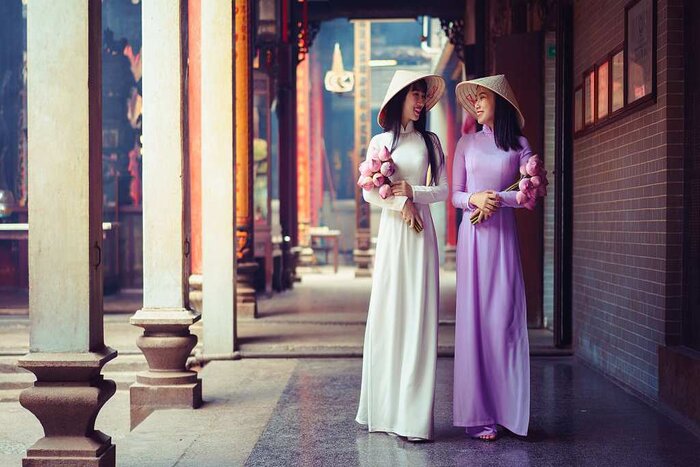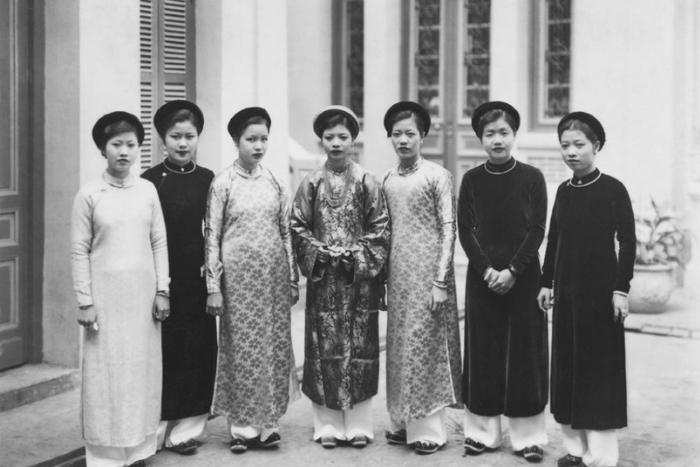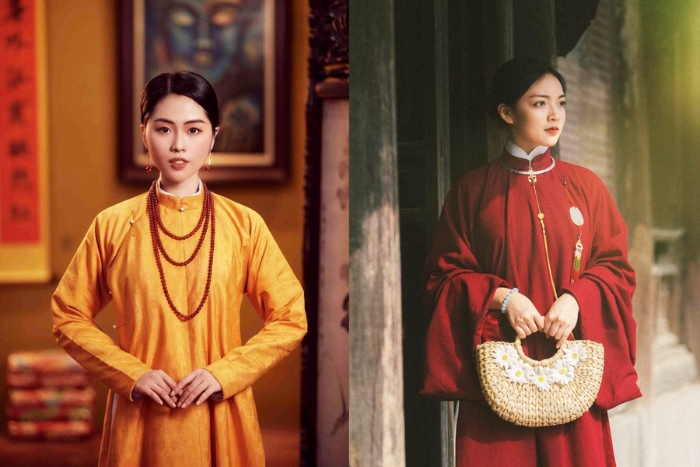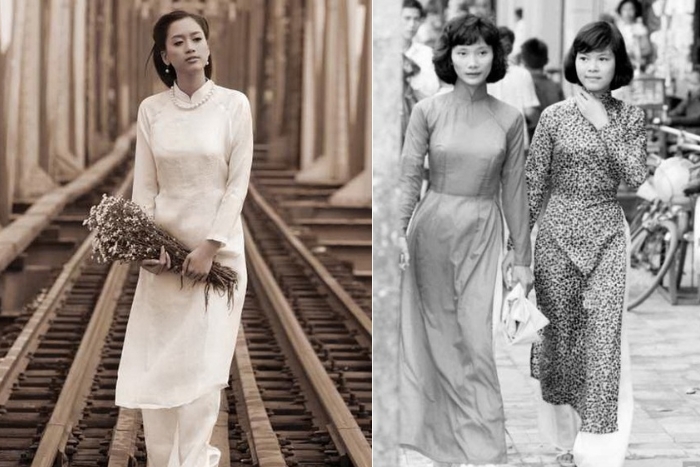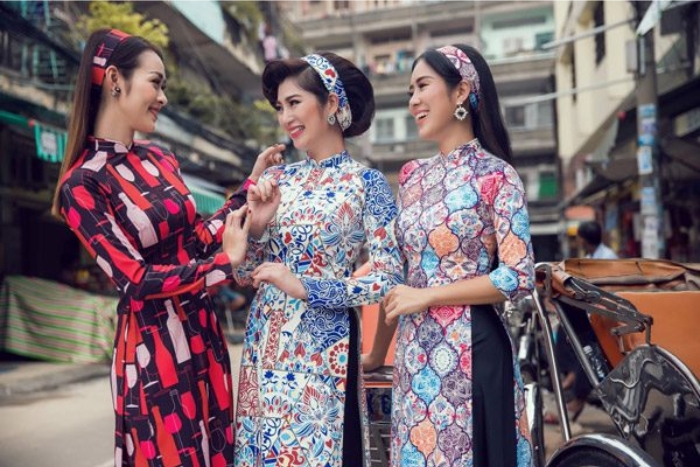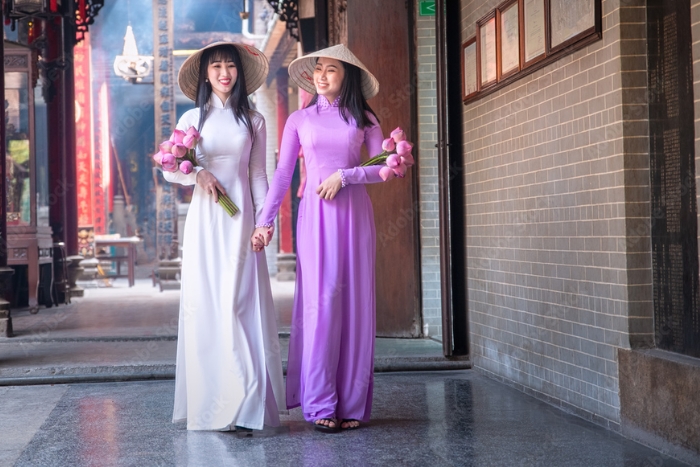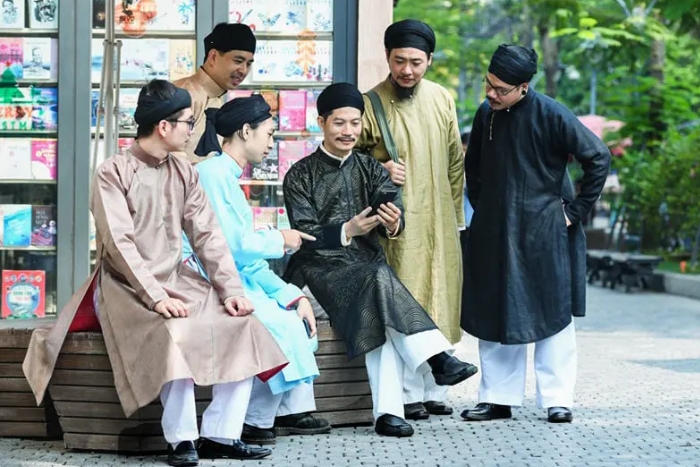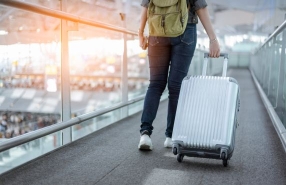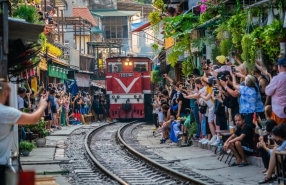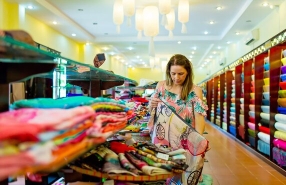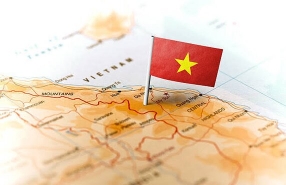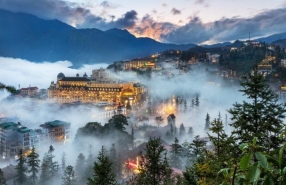Vietnamese traditional dress (Áo dài) offers a vivid snapshot of the nation's rich cultural tapestry, where each garment tells a unique story of history and tradition. From elegant gowns to intricate weaves, these outfits are more than mere clothing, they are expressions of national pride and cultural identity. Join with Autour Asia to explore traditional vietnamese costume, and embark on an unforgettable journey into the heart of the country’s heritage.
I. Introduction about traditional Vietnamese dress
Áo dài is the vietnamese traditional clothing, which was innovated from the "ngũ thân lập linh" shirt and developed from the Westernization period or also known as the modern shirt. From men to women, everyone can wear the ao dai with pride and national pride.
Nowadays, áo dài is a symbolic costume of Vietnam, expressing cultural features, symbolising the gentle and graceful beauty of Vietnamese women.
A traditional áo dài consists of sleeves, collar, two panels and pants. The collar is usually sewn about 3cm high, the sleeves are long to the wrist, the body of this Vietnamese traditional dress is designed to hug the body with buttons or fastenings on one side. This traditional costume has 2 panels, split from the waist to near the ankle. There will be pleats on the chest and back. Pants worn with áo dài will be from the waist to the ankle or can be long to the heel, with wide legs.
Áo dài Vietnam not only reflects the grace and beauty of Vietnamese women but also embodies the nation’s pride and identity. Its design, often featuring intricate embroidery and vibrant colours, represents the harmonious balance between tradition and contemporary fashion, making the Vietnamese traditional clothing a cherished symbol of Vietnam’s enduring cultural legacy.
II. History of traditional Vietnamese dress
Áo dài tradition of the Vietnamese people has gone through many periods of development, each period has its own distinct characteristics.
The ancient origin
The first version of today's áo dài is the áo giao lĩnh (ngũ thân lập linh - five panels) - born in 1744 during the reign of Lord Nguyen Phuc Khoat. Áo giao lĩnh, a traditional cross-collared robe worn by both men and women, was common during the early dynasties. This garment was typically loose-fitting and worn with a sash around the waist, reflecting the influence of neighbouring Chinese culture, particularly during periods of Chinese occupation.
This design symbolised the wearer’s social status, with differences in colour, fabric, and accessories indicating the class and rank of the individual.
Áo tứ Thân (Four-panel dress)
The "áo tứ thân" is a Vietnamese traditional clothing garment of Northern Vietnamese women, characterised by its four panels: two in the front and two in the back. The front panels are usually brown or black, paired with an inner bodice. A silk sash tied around the waist accentuates the wearer’s slim figure. Áo tứ thân is usually dark in colour because this outfit is commonly used by the peasant class - people who work in the fields all year round. The "áo tứ thân" embodies the simple, modest beauty and resilient spirit of Vietnamese women. Today, it is still worn during festivals, preserving the rich cultural heritage.
Áo ngũ thân (Five-panel dress)
In the 19th century, áo ngũ thân (five-panel dress) was introduced to distinguish between the noble and peasant classes. Building upon the four-panel dress, an additional inner layer, forming the fifth panel, was added to the front, providing a subtle, elegant touch. This version of the Vietnamese traditional clothing featured a loose fit and a collar, becoming widely popular until the early 20th century. It is said that the ancient five-panel shirt symbolised the noble ideals of human beings: the four panels of the front and back flaps symbolised the "four parents" (tứ thân phụ mẫu) and the inner panel symbolised the wearer.
Áo dài Lemur, a new version of áo dài vietnam
In the early decades of the 20th century, the Lemur Ao Dai was created by the creative hand of artist Cat Tuong. This type of Vietnamese traditional dress was tailored to hug the body, with only two flaps in the front and back, the front flap reaching the ground. To create a highlight, the Lemur Ao Dai was Europeanized with a waist-cinched shirt, straight sleeves and a thin hem. The buttons were opened to the side to emphasise femininity, this style of shirt was popular until 1943 when it was forgotten.
Áo dài Lê Phổ
This is also a new combination of the four-panel dress, a variation of the áo dài Lemur by artist Lê Phổ, so it is called áo dài Lê Phổ.
Under the skillful hands of the designer of the same name, she reduced the size of áo dài traditional to fit the body of Vietnamese women, pushed up the shoulders, lengthened the Ao Dai to touch the ground and brought many new colours. In other words, she made it more sexy, sophisticated and attractive. This is an Ao Dai that received a lot of praise and was used through many periods. From this time until the 1950s, the Vietnamese Ao Dai style became extremely famous in the country's tradition.
Áo dài Raglan
In the 1960s, áo dài Raglan (also known as the Jacklang Ao Dai) was created by a Dung tailor in Dakao, Saigon. The biggest difference of this áo dài vietnam is that the Ao Dai hugs the body more closely, the sleeves are connected from the neck down at a 45-degree angle to help the wearer be more comfortable and flexible. The two panels are connected by a row of buttons on the side. This is the style that contributed to shaping the style of traditional vietnamese costume later.
Modern Áo dài
Up to now, Vietnamese áo dài has changed with many styles and materials from modern to innovative. Ao Dai has also been transformed into wedding dresses, innovative dresses, ... But no matter what, the traditional Ao Dai of Vietnamese women still retains the charm and modesty that no other outfit has.
Along with the dynamic and changing trend of modern lifestyle, traditional Ao Dai is stylized by designers with a shorter panel, changes in the collar, sleeves or even the skirt or pants worn with Ao Dai, giving Vietnamese women many choices.
The áo dài vietnam is more than just a piece of clothing; it is a symbol of Vietnamese culture, embodying the country’s history, values, and spirit. The design of the áo dài reflects the principles of balance and harmony, with its flowing lines representing the natural beauty of the Vietnamese landscape. This traditional vietnamese costume is also imbued with symbolism, with different colours and styles conveying various meanings:
Red: symbolises good luck and prosperity, often worn by brides during weddings.
White: represents purity and innocence, traditionally worn by young girls and students.
Blue or Green: associated with peace and calm, sometimes worn during religious ceremonies
With such a long history of development, the Vietnamese áo dài has become more perfect than ever. This Vietnamese costum has become a symbol of culture, enhancing the beauty of Vietnamese women.
III. Colour and occasion to wear traditional Vietnamese dress
Traditional Vietnamese dress for men is similar to traditional Vietnamese dress for females, but the waist is not sewn to hug the body, the body of the Ao Dai is often straight and straight, expressing masculinity, strength and maturity.
1. Vietnam traditional dress for males
The traditional Vietnamese dress for men is characterised by its long, flowing tunic with a high, stiff collar, extending to just above the knees, and worn over loose-fitting trousers. The tunic is often made from rich, durable materials such as silk, brocade, or cotton, providing both comfort and an elegant appearance.
In terms of colour, traditional Vietnamese dress for men typically features darker, more subdued hues such as deep blue, black, or maroon, symbolising strength, dignity, and formality. However, during festive occasions or religious ceremonies, brighter colours like red or gold might be worn to convey prosperity and joy. The design is often minimalist, with subtle embroidery or patterns that reflect the wearer's social status or the occasion's significance. This traditional vietnamese costume, while steeped in history, continues to be worn in modern-day Vietnam, bridging the past and present through its timeless elegance and cultural significance.
2. Vietnam traditional dress for females
The traditional Vietnamese dress for females is a symbol of elegance, grace, and cultural identity. This iconic garment features a long, form-fitting tunic with a high collar and side slits that extend up to the waist, paired with loose-fitting trousers. Áo dài Vietnam for women is crafted from luxurious fabrics such as silk, satin, or chiffon, which flow beautifully, enhancing the wearer’s silhouette and movement. Often, the tunic is adorned with intricate embroidery or delicate patterns that add a touch of sophistication and personal expression. The colours that are always favoured by women are red, pink or blue, which are popular on special occasions, symbolising joy, prosperity and love.

The áo dài traditional is often paired with the nón lá, a traditional conical hat made from palm leaves, which not only provides practical sun protection but also adds an element of timeless elegance to the ensemble. This combination creates a harmonious blend of style and tradition, embodying the delicate yet resilient spirit of Vietnamese women. The áo dài is worn during various important events, including festivals, weddings, and formal gatherings, making it a versatile and enduring symbol of Vietnamese culture and heritage.
3. Occasion to wear traditional Vietnamese dress
The traditional Vietnamese dress, áo dài, is worn on various special occasions that highlight its cultural significance and elegance. One of the most common occasions is during Tết, the Lunar New Year, when both men and women don the áo dài to celebrate the most important holiday in Vietnam, symbolising a fresh start and honouring cultural traditions.
The áo dài is also widely cherished as a traditional
Vietnamese wedding dress, where brides often choose red or gold áo dài for their symbolic meanings of luck and happiness. Female family members and bridesmaids might also wear áo dài in coordinated colours to complement the event's theme.
In addition to these personal celebrations, the áo dài is worn during national holidays, such as Independence Day, and at cultural festivals, where it serves as a proud emblem of Vietnamese heritage. Students, particularly girls in high school, frequently wear white áo dài as their uniform, representing purity and youth.
Vietnamese traditional clothing is also the attire of choice for official ceremonies, diplomatic events, and formal gatherings, where it showcases Vietnam's rich history and cultural identity. Even in modern contexts, this cloth remains a beloved and respected garment, symbolising both tradition and contemporary elegance.
In recent years, the áo dài has gained international recognition as a symbol of Vietnam’s rich cultural heritage. It is often showcased in fashion shows, cultural exhibitions, and international events, highlighting its timeless elegance and enduring appeal. Additionally, this
traditional vietnamese costume leaves a lasting impression on tourists, earning their trust as a beautiful and meaningful
souvenir from Vietnam to bring home.
When visiting Vietnam, be sure to take home a bespoke Vietnamese traditional clothing from one of these renowned áo dài shops in Hanoi. IV. Other traditional vietnamese dress of ethnic group
1. Thai people
The White Thai ethnic group in Vietnam is known for their elegant Vietnamese traditional clothing, reflecting their cultural identity and connection to nature. Women wear a fitted blouse called "Pieu". adorned with delicate embroidery around the collar and sleeves, paired with a long black skirt known as "Sinh", which features intricate designs at the hem. A colourful Pieu scarf adds grace to the outfit, symbolising beauty and tradition. Men typically wear simple, dignified attire consisting of a light-coloured shirt with a Mandarin collar and loose trousers, embodying values of purity and simplicity.
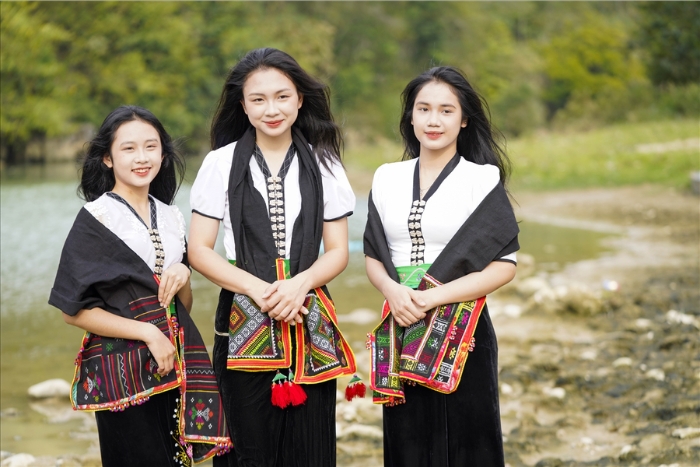
The Black Thai ethnic group’s traditional vietnamese costume is characterised by its darker tones and robust design, reflecting strength and resilience. Women wear a dark blouse with silver buttons, often shaped like butterflies or spiders, paired with a black skirt accented by colourful bands at the hem. The dark Pieu scarf headscarf symbolises their connection to the mountainous regions. Men wear practical, dark-coloured shirts and trousers, often with a fabric belt, reflecting their hardworking nature.
2. H’mong people
The H’mong people in Vietnam are recognized for their vibrant and intricately crafted traditional dress, which vividly expresses their cultural identity and craftsmanship. Each H’mong subgroup, such as the Flower H’mong, Black H’mong, and Green H’mong, has its unique style, but all share a love for bright colours and detailed embroidery.
Women typically wear colourful pleated skirts and jackets adorned with intricate patterns created through embroidery, appliqué, and batik techniques. These outfits often feature vivid colours like red, blue, and green, enhanced with silver jewellery, symbolising joy and prosperity. Men's traditional clothing, though simpler, includes detailed embroidery on dark, earthy-toned shirts and pants. The H’mong traditional vietnamese costume is more than just attire; it reflects their history, beliefs, and artistic heritage, proudly worn during festivals, ceremonies, and daily life.
V. Some note when wear traditional vietnamese dress
When wearing the traditional Vietnamese áo dài it's important to keep the following points in mind.
- Cultural appreciation: While wearing traditional Vietnamese dress, it’s important to do so with respect for the cultural significance of the garment. Understanding and appreciating its cultural background enhances the experience.
- Proper undergarments: Choose seamless, well-fitting undergarments that do not show through the fabric, especially when wearing lighter colours.
- Minimal accessories: Keep accessories simple and minimal to avoid overshadowing the dress’s delicate design; a small brooch or a pair of pearl earrings often suffice.
- Comfortable footwear: Pair áo dài Vietnam with low heels or traditional Vietnamese slippers (guốc) to complement its flowing design.
- Weather considerations: In warmer climates, opt for lighter fabrics like silk or linen, and consider layering with a shawl or jacket in cooler weather.
In exploring the traditional Vietnamese dress, one uncovers a deep connection to the country's rich cultural heritage. The elegance, symbolism, and timeless beauty of the áo dài reflect the values and history of Vietnam, offering a window into the nation’s identity. Whether worn during significant celebrations, cultural festivals, or formal gatherings, the áo dài traditional is more than just attire, it is a living representation of Vietnam's enduring traditions and the grace of its people. Discovering the áo dài is, in essence, discovering the heart of Vietnamese culture.
If you have special stories about
áo dài traditional or unforgettable experiences with this
traditional Vietnamese costume, don't hesitate to share with
AUTOUR ASIA - best Vietnam travel agency
How long does it take to make a custom áo dài for tourists?
The time it takes to make a áo dài traditional depends on the complexity of the design and the tailor's schedule. Generally, it can take anywhere a few days. In busy periods, such as before the Tết holiday (Vietnamese New Year), it might take longer, so it's advisable to plan ahead if you're ordering a custom piece.
Are there regional differences in how the áo dài is worn?
Yes, there can be regional variations in the style and fabric of the áo dài. For example, in southern Vietnam, traditional vietnamese dress might be made from lighter materials due to the warmer climate, while in the north, it might be thicker or layered. Additionally, the style of the collar or sleeves might differ slightly depending on regional fashion trends.
Besides clothes, is there anything else I need to pay attention to when coming to Vietnam?
When traveling to Vietnam, there are several things beyond clothing that you should consider to ensure a smooth and enjoyable trip such as: Vietnam visa, currency Vietnam, Vietnam checked baggage,...
>>> Clique here for details informations: Vietnam Travel Guide

